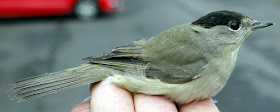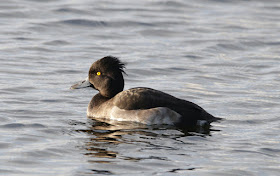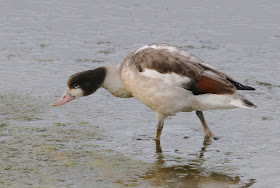Saturday morning and there was time for a whizz around Conder Green before I met up with Andy at lunchtime. We’d agreed to take part in a “Wild Day” at Cockerham.
But first. Early doors showed things were pretty tame at Conder Green despite the sight of 380 Lapwings, the most I've seen here this autumn. Mostly the Lapwings stayed on the island or the rough grass beyond and very few ventured close to the viewpoint.
Lapwing
Lapwing numbers fluctuate here according to the tidal bore of the River Lune a quarter of a mile away. It’s not unusual to see three or even four thousand Lapwing on the Lune sandbanks in autumn and winter where they often mix closely with flocks of Golden Plovers and Redshanks.
Waders otherwise numbered 95 Redshank, 10 Curlew, 10 Oystercatcher, 5 Black-tailed Godwit, 4 Common Sandpiper and 2 Snipe.
It was good to see a brood of 5 young Shelduck and although there were no adults, the young seemed quite independent. In recent years it has become increasingly difficult to find broods of Shelduck along the shores and estuaries that they favour.
British Trust for Ornithology (BTO) figures suggest that the overall UK and Ireland population of Shelduck is stable. Maybe it’s a local issue, especially on our shores where disturbance has become very regular and more prolonged. It’s no longer just a weekend problem with the human disturbance affecting every one of the many species of coastal waders and wildfowl.
Shelduck
Shelduck - via British Trust for Ornithology
Shelduck were persecuted in the 19th Century in the sandy areas of Britain because they competed with rabbits for burrows to nest in. While in those days rabbits were good eating, the salty Shelduck was less sought after.
Nowadays the Shelduck is a protected species that should not be shot. But living as it does in the close company of “game” ducks like Teal, Mallard and Wigeon, the Shelduck is as wary of man as the wildest of waterfowl and is sometimes shot by inexperienced or cowboy shooters.
Other counts: 10 Little Grebe, 8 Little Egret, 1 Kingfisher and 6 Common Tern.
Between the six or more regular Common Terns there’s feeding the single youngster taking place but also the presenting of fish by male on female. It is rather difficult to tell which individuals are involved in what is likely to be late summer courtship displays, a prelude to the same individuals returning here in 2019 where they will find similarly minded birds. However it is as well to know that Common Terns do not generally breed until their third or even fourth years, and that these courtship rituals may be wishful thinking.
Common Tern
Of course the Common Tern is not just a European species. It is the most widespread and familiar North American tern, known and for its long history as a symbol of the conservation movement. The Common Tern was the impetus for the formation of the Audubon societies and other conservation initiatives of North America. The Common Tern was widely sought after in the late 19th century for the millinery trade, in which feathers, wings, or entire stuffed terns were mounted on fashionable women’s hats.
Slaughter of terns and other seabirds for this purpose peaked in the 1870s and 1880s, and by the end of the century the species was almost lost from the North American Atlantic Coast and many inland areas. Fortunately, the efforts of the burgeoning conservation groups culminated in 1918 with the passage of comprehensive bird protection legislation, the Migratory Bird Treaty between the United States and Canada.
Back to the present, and on the drive through Cockerham village a Barn Owl crossed the road some distance ahead of the car. By now the road was busy with traffic with nowhere to stop but from old I knew the farm it headed for. Along Lancaster Road I found 5 Buzzard in the air together and where at least one of them seemed to be a youngster still begging food.
Buzzard
The afternoon venue was Moss House Caravan Site at Cockerham where our group of bird ringers had agreed to host a table for the annual “Wild Day”. The BTO kindly sent a pile of magazines and a host of leaflets covering a wide variety of bird-related subjects: Garden Plants for Birds , Garden Birdwatch, About The BTO, Nest Recording, Feeding Garden Birds, The Sparrowhawks & Garden Birds, Bird Ringing etc,etc.
Bird Table
We had two separate slides shows running on laptops. The first one showed birds in the field while the second one consisted of birds in the hand and shots of bird ringers doing their thing. We also had several field guides for people to browse. There was great interest in our display and a number of people stopped to ask questions and to talk about the birds they see in the local area.
Other participants included RSPB, Bowland Wildlife and The Naturalists Trust plus exhibits of bee keeping with pots of natural honey to buy. For the kids large and small there was “build a bee” and other entertainment by way of goats and miniature pigs brought along by a local farm.
The afternoon provided an entertaining and valuable exercise in spreading the word about birds. And I came away with a rolled shoulder of goat for the roasting pan together with a jar of real honey.
Honey
Back soon with more news and views. In the meantime keep those comments coming and I will return your visit very soon.
Linking this post to
Stewart's World Bird Wednesday.






















































